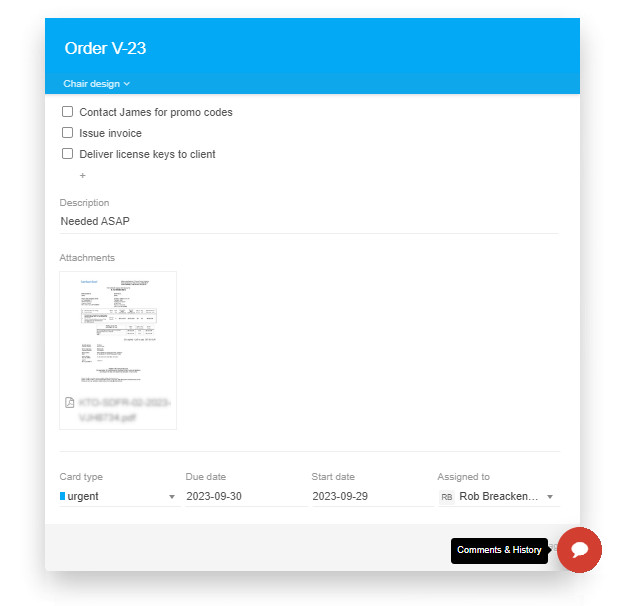Kanban Card

A Kanban card is a visual representation of a single piece of work, placed on a Kanban board. And the card’s position on the board represents the work status, e.g. not yet started, in progress, done. You could think of the card as a relay baton, which during a race has to be carried by the team members, one by one, across different stages until reaching the finish line.
Kanban cards serve to:
- Distribute information in a uniform and consistent way,
- Empower the team and build trust,
- Explain the process to all involved parties, and encourage collaboration,
- Control the flow and capacity of the workflow,
- Record all relayed information and an item’s progress, simplifying handoffs and gathering analytical data.
The invention of Kanban cards
In Japanese, the word Kanban means “signaling card”. At Toyota’s factory floor Kanban cards were the key component signaling the need for replenishment of work. This signal would indicate to team members or suppliers downstream, that their colleagues have completed or are almost done with their work, and need the upstream team to send in more.
Traditional manufacturing systems were grounded in push methods. Orders were worked on in large batches, often with inventory sitting on the shop floor, underutilized. Kanban operates on the concept of just-in-time production, which requests items to be worked on only when they’re in demand.
Kanban cards were stored in bins, and when workers completed work on an item and needed more materials, those bins were sent to the replenishment department to stock up. And when materials were depleted in the replenishment department, card bins were sent to suppliers for new stock.
Toyota noticed that workers prefer pulling work to having work thrust upon them. We can all sympathize with that - what would you prefer: coming in to work in the morning and pulling the first item of your board, or arriving to find your desk loaded with work that someone has dumped there? Kanban cards can transform an office from a push to a pull system.
What information should be on a card?
At Toyota, each card contained information on where it had come from, what type and quantity of work it required, and where it had to be delivered next. The Kanban card has since evolved, and in most electronic systems it has come to represent a freely defined single work item, described by an individually defined data set.
Cards located on the Kanban board signify work requested to be done. They can also contain information on when the item was requested, what’s the goal of the task, and on the author or requester of the item. An important point is that the cards don’t need to contain every little piece of information - just enough to empower the team to make their own decisions to get it done. Despite that, most Kanban practitioners today use digital Kanban cards, given their less-restrictive information capacity, than that of physical cards.
Example Sometimes card information can differ depending on the type of work. For a software development team, a card for fixing a bug and for implementing a feature would contain different sorts of information. The bug reporting card would outline where and when a bug occurs in the application, while a feature requesting card would describe the expected behavior of the new functionality.
It’s common for systems to allow the cards to contain a job number, a date of the card’s initiation, team members associated with its completion, various estimations, and much more. Electronic tools are also known for giving color, design, icon, or text indicators to show a card’s age, type, level of recent activity, etc.

Did you know?
Kanban Tool® cards, though minimalist in design, can hold all of your task information: ID, description, assignment, due date, dependencies, attachments, estimations, priority, checklists, comments, up to 15 custom fields, and more.
Give it a try - make your Kanban cards as concise or elaborate as you want to.
A tool of trust and visual control
Kanban cards establish trust by letting the team members know exactly what to work on and when to do it. The fact that these directions can be obtained individually breeds a sense of empowerment among the team. Kanban cards grant authority and prevent from working on low priority items, which should not be in circulation before high priority tasks are done with.
A Kanban board works as a visual control system. Simply walking past a board and seeing Kanban cards falling off can indicate that perhaps the team is overloaded. Backlog cards should not be allocated to a specific person, but team members should themselves pull those cards that they feel most able to work on. That way work is encouraged rather than being forced upon people.
However, card distribution should be kept in check, alongside the board, to protect team members. If someone is already working on their full quota, they should not be allowed to pull any more cards, until they have finished with the items they have open – something that can be ensured through per-person WIP limits. Cards that have not been moving can be color-coded to become chief talking points during the morning stand-up. Team members can explain why an item has been stuck and can work together to see how to get the item moving.